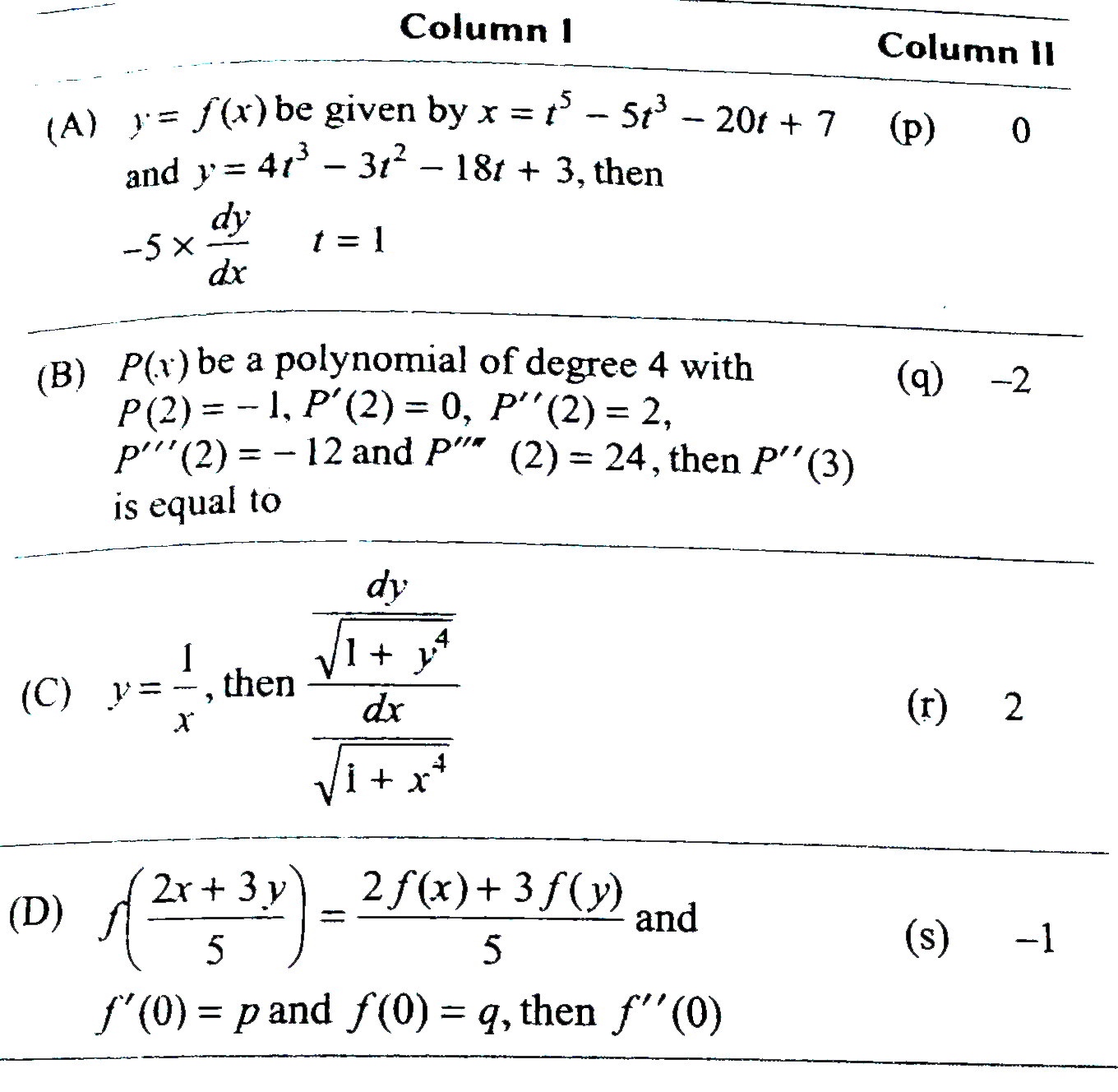A curve is represented paramtrically by the equations x=etcost and y=etsint where t is a parameter. Then
The value of d2ydx2 at the point where t=0 is
1
2
-2
3
The correct Answer is:B
To find the value of d2ydx2 at the point where t=0 for the given parametric equations x=etcost and y=etsint, we will follow these steps:
Step 1: Differentiate x and y with respect to t
1. Differentiate x:
dxdt=ddt(etcost)=etcost+et(−sint)=et(cost−sint)
2. Differentiate y:
dydt=ddt(etsint)=etsint+etcost=et(sint+cost)
Step 2: Find dydx
Using the chain rule:
dydx=dy/dtdx/dt=et(sint+cost)et(cost−sint)=sint+costcost−sint
Step 3: Differentiate dydx to find d2ydx2
Using the quotient rule:
d2ydx2=ddt(dydx)⋅1dxdt
Let u=sint+cost and v=cost−sint:
ddt(uv)=vdudt−udvdtv2
Calculating dudt and dvdt:
dudt=cost−sint
dvdt=−sint−cost
Now substituting:
ddt(dydx)=(cost−sint)(cost−sint)−(sint+cost)(−sint−cost)(cost−sint)2
Step 4: Substitute t=0
At t=0:
- x=e0cos(0)=1
- y=e0sin(0)=0
Now substituting t=0 into the derivatives:
dudt=cos(0)−sin(0)=1
dvdt=−sin(0)−cos(0)=−1
Now substituting back into the expression for d2ydx2:
d2ydx2=(cos(0)−sin(0))2−(sin(0)+cos(0))(−sin(0)−cos(0))(cos(0)−sin(0))2⋅1dxdt
Calculating:
d2ydx2=(1)2−(0)(−1)(1)2⋅11=11=2
Final Answer:
Thus, the value of d2ydx2 at t=0 is 2.
---
dxdt=ddt(etcost)=etcost+et(−sint)=et(cost−sint)
dydt=ddt(etsint)=etsint+etcost=et(sint+cost)
dydx=dy/dtdx/dt=et(sint+cost)et(cost−sint)=sint+costcost−sint
d2ydx2=ddt(dydx)⋅1dxdt
ddt(uv)=vdudt−udvdtv2
dudt=cost−sint
dvdt=−sint−cost
ddt(dydx)=(cost−sint)(cost−sint)−(sint+cost)(−sint−cost)(cost−sint)2
- x=e0cos(0)=1
- y=e0sin(0)=0
dudt=cos(0)−sin(0)=1
dvdt=−sin(0)−cos(0)=−1
d2ydx2=(cos(0)−sin(0))2−(sin(0)+cos(0))(−sin(0)−cos(0))(cos(0)−sin(0))2⋅1dxdt
d2ydx2=(1)2−(0)(−1)(1)2⋅11=11=2
Thus, the value of d2ydx2 at t=0 is 2.
Topper's Solved these Questions
- DIFFERENTIATION BOOK - ARIHANT MATHS ENGLISHCHAPTER - DIFFERENTIATION EXERCISE - Differentiation Exercise 5:
1 Video
- DIFFERENTIATION BOOK - ARIHANT MATHS ENGLISHCHAPTER - DIFFERENTIATION EXERCISE - Exercise (Subjective Type Questions)
14 Videos
- DIFFERENTIATION BOOK - ARIHANT MATHS ENGLISHCHAPTER - DIFFERENTIATION EXERCISE - Exercise (Statement I And Ii Type Questions)
10 Videos
- DIFFERENTIAL EQUATION BOOK - ARIHANT MATHS ENGLISHCHAPTER - DIFFERENTIAL EQUATION EXERCISE - Exercise (Questions Asked In Previous 13 Years Exam)
26 Videos
- DY / DX AS A RATE MEASURER AND TANGENTS, NORMALS BOOK - ARIHANT MATHS ENGLISHCHAPTER - DY / DX AS A RATE MEASURER AND TANGENTS, NORMALS EXERCISE - Exercise (Questions Asked In Previous 13 Years Exam)
7 Videos
Similar Questions
Match the entries between the following two columns.

View Solutionf:R→R,f(x)=x3+x2f'(1)+xf''(2)+f'''(3) for all x∈R.
The value of f(1) is
View SolutionConsider f(x)=xx2−1
Statement I Graph of f(x) is concave up for x>1.
Statement II If f(x) is concave up then f''(x)>0
View SolutionIf f:R−{−1}→Randf is differentiable function satisfies:
f((x)+f(y)+xf(y))=y+f(x)+yf(x)∀x,
y∈R−{_1} Find f(x).
View SolutionThe slope of the tangent to the curve (y−x5)2=x(1+x2)2 at the point (1,3) is.
View SolutionWhich of the following equations in parametric form can represent a hyperbolic profile, where t is a parameter: (A)x=(a)/(2)(t+(1)/(t))&y=(b)/(2)(t-(1)/(t))(B)t(x)/(a)-(y)/(b)+t=0&(x)/(a)+t(y)/(b)-1=0(C)x=e^(t)+e^(-t)&y=e^(t)-e^(-t)(D)x^(2)-6=2cos t&y^(2)+2=4cos^((t)/(2))
View SolutionA curve is represented paramtrically by the equations x=etcost and y=etsint where t is a parameter. Then
The value of d2ydx2 at the point where t=0 is
View Solutiondydx ज्ञात कीजिए -
x=et(sint+cost),y=et(sint−cost)
View Solutionयदि x=a(cost+tsint) और y=a(sint−tcost), तो d2ydx2 ज्ञात कीजिए ।
View SolutionA curve is represented parametrically by the equations x=e1costandy=e1sint, where t is a parameter. Then, If F(t)=∫(x+y)dt, then the value of F(π2)−F(0) is
View SolutionIf x=etsint and y=etcost, then the value of (x+y)2d2ydx2−2xdydx is -
View SolutionFind dydx, if x and y are connected parametrically by the equations, given below without eliminating the parameter:
x=etcost,y=etsint at t=π2.
View Solutionযদি x=etsint এবং y=etcost হয়, তবে [{(x+y)²×d²ydx²}−2x(dydx)] এর মান হবে---
View SolutionIf x=etsintandy=et cos t, t is a parameter , then the value of d2xdy2+d2ydx2 at t = 0 , is :
View SolutionIf x=aet(sint+cost) and y=aet(sint−cost), prove that dydx=x+yx−y.
View Solution

